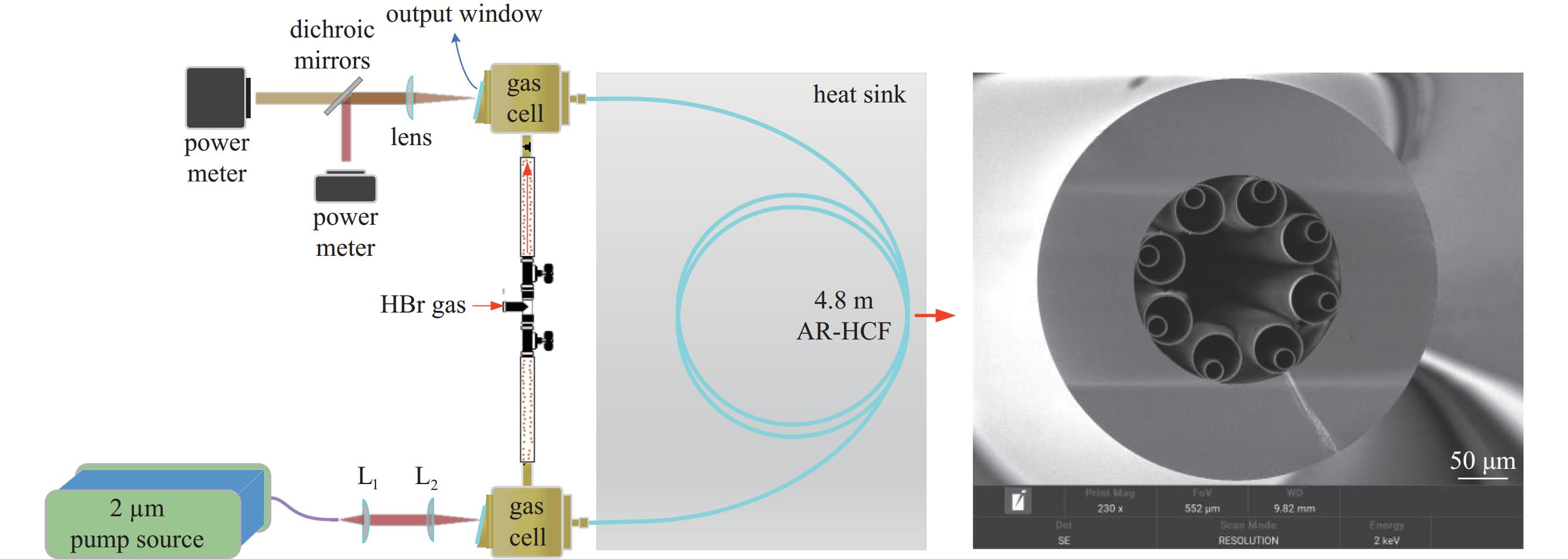Fiber gas laser beyond 4 μm with output power of over 10 W
-
摘要: 中红外激光器在医疗、通信和国防等领域具有重要应用需求,近年来,围绕中红外光纤激光器的研究引起国内外广泛关注。采用自研的2 μm单频光纤激光放大器作为泵浦光源,利用气体分子的本征吸收实现粒子数反转,基于溴化氢(HBr)气体填充的反谐振空芯光纤(AR-HCF)实现了波长为4.16 μm处大于10 W的中红外光源连续输出。通过采用大模场反谐振空芯光纤及后向气体填充的方式,在提高光光转换效率的同时有效抑制了热积累限制。在最大注入泵浦功率为63.8 W下,实现中红外光源最大连续输出功率10.37 W,对应斜率效率约为16.8%,最大功率下光束质量M2 <1.1。研究结果证明了光纤气体激光器在产生高功率中红外光源方面的重要能力,对于中红外光纤激光技术的发展和研究具有重要的指导意义。Abstract: Mid-infrared lasers hold significant application demands in fields such as medicine, communications, and national defense. In recent years, research on mid-infrared fiber lasers has attracted extensive attention worldwide. This work demonstrates a high-power mid-infrared light source at 4.16 μm utilizing HBr gas-filled anti-resonant hollow-core fiber (AR-HCF). By employing a homemade 2 μm single-frequency fiber amplifier as the pump source and utilizing the intrinsic absorption of gas molecules to achieve population inversion, we have realized over 10 W continuous wave mid-infrared output through backward gas-filling method in large-mode-area (AR-HCF). This optimized configuration simultaneously enhances the optical-to-optical conversion efficiency and effectively suppresses thermal accumulation limitations. At the maximum incident pump power of 63.8 W, the system achieves a maximum continuous output power of 10.37 W with corresponding slope efficiency of approximately 16.8%. The beam quality measurement reveals M2<1.1 at maximum power operation. This research verifies the substantial capability of fiber gas lasers to generate high-power mid-infrared radiation, providing valuable insights for advancing the development and investigation of mid-infrared fiber laser technologies.
-
Key words:
- fiber laser /
- high power /
- mid-infrared /
- hydrogen bromide /
- hollow-core fiber
-
[1] Jackson S D. Towards high-power mid-infrared emission from a fibre laser[J]. Nature Photonics, 2012, 6(7): 423-431. doi: 10.1038/nphoton.2012.149 [2] Zhou Pujun, Wang Xianliang, Ma Yinzhe, et al. Review on recent progress on mid-infrared fiber lasers[J]. Laser Physics, 2012, 22(11): 1744-1751. doi: 10.1134/S1054660X12110199 [3] 王泽锋, 黄威, 李智贤, 等. 光纤气体激光光源研究进展及展望(Ⅰ): 基于受激拉曼散射[J]. 中国激光, 2021, 48:0401008 doi: 10.3788/CJL202148.0401008Wang Zefeng, Huang Wei, Li Zhixian, et al. Progress and prospects of fiber gas laser sources (I): based on stimulated raman scattering[J]. Chinese Journal of Lasers, 2021, 48: 0401008 doi: 10.3788/CJL202148.0401008 [4] 王泽锋, 周智越, 崔宇龙, 等. 光纤气体激光光源研究进展及展望(Ⅱ): 基于粒子数反转[J]. 中国激光, 2021, 48:0401009 doi: 10.3788/CJL202148.0401009Wang Zefeng, Zhou Zhiyue, Cui Yulong, et al. Research progress and prospect of fiber gas laser sources (II): based on population inversion[J]. Chinese Journal of Lasers, 2021, 48: 0401009 doi: 10.3788/CJL202148.0401009 [5] Grebnev K, Perminov B, Fernandez T T, et al. Fluoride and chalcogenide glass fiber components for mid-infrared lasers and amplifiers: Breakthroughs, challenges, and future perspective[J]. APL Photonics, 2024, 9: 110901. doi: 10.1063/5.0225887 [6] Boilard T, Fortin V, Lemieux-Tanguay M, et al. 1.7 W holmium-doped fluoroindate fiber laser at 3920 nm[J]. Optics Letters, 2024, 49(10): 2677-2680. doi: 10.1364/OL.522233 [7] Koltashev V V, Denker B I, Galagan B I, et al. 150 mW Tb3+ doped chalcogenide glass fiber laser emitting at λ > 5 μm[J]. Optics & Laser Technology, 2023, 161: 109233. [8] Song Weihua, Yao Jingyuan, Zhang Xin, et al. 4.3 µm high-power amplified spontaneous emission fiber source based on CO2-filled nested hollow-core anti-resonant fiber[J]. Optics Express, 2024, 32(8): 14532-14540. doi: 10.1364/OE.517713 -





 下载:
下载:


